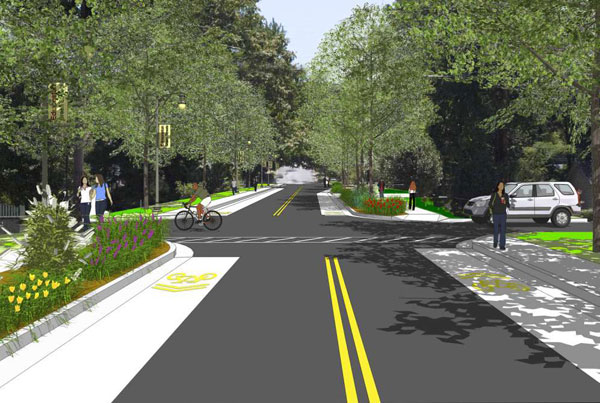Interview
Interview with Congresswoman Donna Edwards
 Image credit: Office of Donna Edwards
Image credit: Office of Donna EdwardsWe’ve all heard in the news how flooding has ravaged southern communities. However, there’s been little discussion of how green infrastructure could help mitigate the impact of natural storms. What is your case for using green infrastructure to address flooding?
The case is straightforward. We know that using green infrastructure is the best, most cost-effective way to address flooding because green infrastructure relies on the natural environment to manage stormwater. Specifically, using urban flood plains that provide repositories for flood water prevents storm and flood water runoff and provides additional green space for communities. This is the type of innovative development the Green Infrastructure for Clean Water Act (H.R. 2030) aims to enhance and incentivize.
Your proposed legislation would incentivize the use of green infrastructure. Are the issues in urban, suburban, and rural communities different? Do all types of communities benefit?
Yes, absolutely. The issues vary by region, which is the reason that H.R. 2030 would establish up to five regional Centers of Excellence for green infrastructure in the United States. The centers would be charged with conducting research on green infrastructure relevant to the geographic region where the center is located. Communities would then receive training and technical assistance on how to implement the best green infrastructure management practices.
In another town, Edmonston, the mayor and town council created a model green street using E.P.A. recovery funds. The new green infrastructure system helps the town manage the run-off that used to lead to massive flooding and damages. What was the key to their success? Beyond the new stormwater management infrastructure, what economic and social benefits have Edmonston gained from the green street?
I am excited about the Edmonston success story – it’s a small town success in my Congressional District. The two keys to Edmonston’s success were grant assistance and a commitment to building a sustainable community. Due to stormwater runoff, Edmonston had flooded four times in the previous decade. For a community of just 1,300 people, this was unsustainable. At a cost of $1.3 million, Edmonston’s green street brought good jobs, sustainable flood control, low-cost LED streetlights, and quality of life improvements for residents. Importantly, Edmonston now pays just $3,000 dollars a year to maintain their green street, as opposed to the hundreds of thousands of dollars they were forced to pay when the town flooded. These benefits are real, proving that the right investments in green infrastructure can benefit communities across our country.
 Town of Edmonston Green Street / Edmonston
Town of Edmonston Green Street / Edmonston
California provides another great example of the benefits of green infrastructure on a much larger scale. The Sun Valley Watershed is an alternative to a $42 million concrete drain to eliminate flooding in the Sun Valley. With funding from 20 state and federal agencies, the multi-purpose project returned $100 million in savings in recaptured water, cleaner air, and reduced waste hauling. Contrasting this with the Edmonston example captures the expansive benefits of green infrastructure – from aiding small communities to reinventing vast infrastructure projects.
Cities with old stormwater infrastructure pipes like Philadelphia and New York City are developing green infrastructure plans. More and more cities view green infrastructure as a relatively low-cost way to add stormwater management capacity without building out more expensive, underground, and centralized systems. Philadelphia has led the way in creating a $1.6 billion, 20-year green infrastructure plan that would be funded by local fees on water run-off. Do you think this fee-based approach is the way forward?
I think it’s important to enable city, state, and local governments to figure out ways to design, build, and fund green infrastructure initiatives. At the federal level, our job as legislators is to incentivize the green infrastructure, enhance current techniques, and develop best practices for future opportunities and varied approaches in varied communities.
Green infrastructure has been unfairly labeled a liberal cause. Why is this? Has there been errors in how it’s been positioned?
Well, I think the reality is a tendency to associate the word “green” with the word “liberal,” but the truth is that disasters from stormwater occur all over the country and across all ideologies. The facts of green infrastructure are not political. The example of Edmonston is testament to how we can combine smart economic development with sound environmental stewardship. I believe that the more communities like Edmonston benefit from green infrastructure, the less politicized the issue will be.
Lastly, what can landscape architects, who are major supporters of green infrastructure, do to support your legislation? What else can landscape architects do in their own communities?
Landscape architects are in the position to discuss green infrastructure with authority and expertise but without bias. It’s important to use that platform to educate communities about the wide ranging benefits of green infrastructure for our environment and our economy. Landscape architects can educate the public and elected officials across ideological lines.
Congresswoman Donna Edwards represents the 4th Congressional District of Maryland.
Interview conducted by Jared Green.